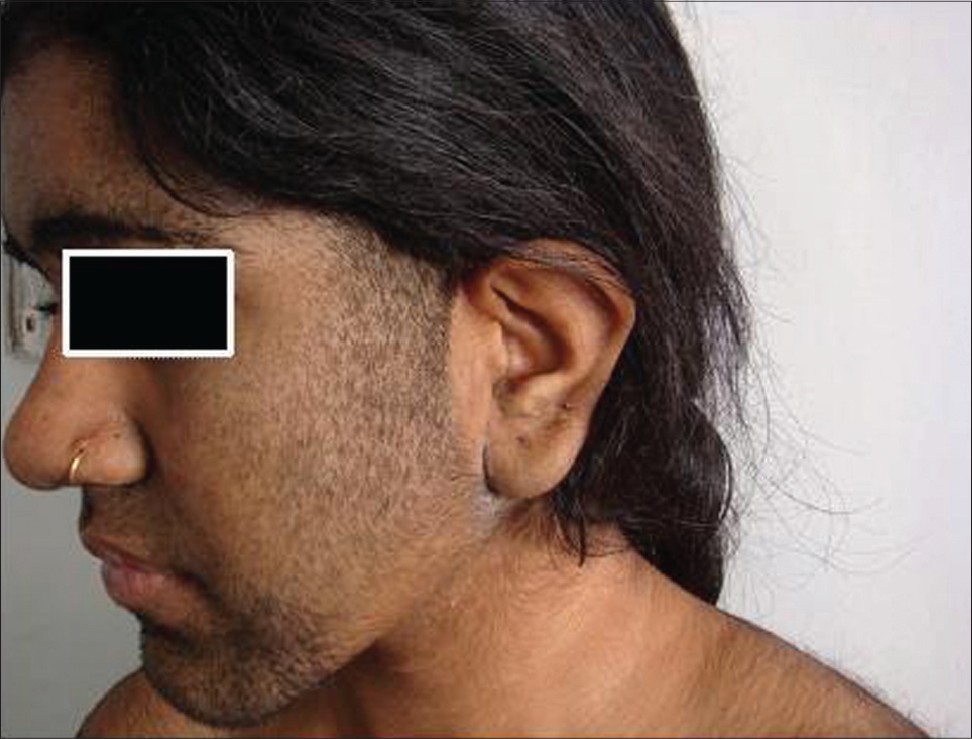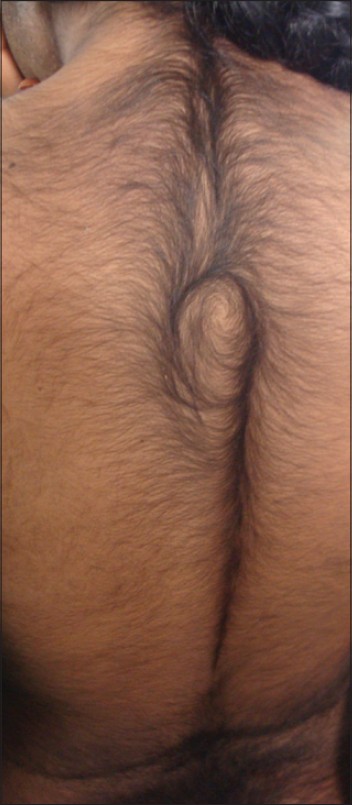Translate this page into:
Familial congenital generalized hypertrichosis
Correspondence Address:
Bindiya Gupta
Department of Obstetrics and Gynecology, UCMS and GTB Hospital, Dilshad Garden, Delhi
India
| How to cite this article: Goel N, Rajaram S, Gupta B, Gupta K. Familial congenital generalized hypertrichosis. Indian J Dermatol Venereol Leprol 2013;79:849 |
Sir,
Hypertrichosis is defined as an abnormal hair growth resulting in an increase in body hair beyond the normal variation for a patient′s reference group; excluding androgen-induced hair growth. This should be differentiated from hirsutism, which is increased hair growth in androgen dependent areas. [1] It is usually a cosmetic problem, but may be associated with an underlying disorder that requires further investigation. It has been classified into congenital and acquired with further subdivision into generalized or localized hypertrichosis. [2] We present a rare case of familial congenital generalized hypertrichosis, which on literature search has been reported in very few families worldwide.
An 18-year-old girl, presented with profuse hair growth over face, arms, legs and back since birth. Her thelarche and menarche were normal and menstrual cycles were regular with normal flow. There was no history of acne, weight gain or voice change. Both her mother and maternal grandmother had a similar history of extensive body hair while her two sisters were normal. On examination, she was phenotypically female with a body mass index of 26. Extensive, soft, black terminal hair, 3-4 cm long was present on the face (shaved), arms, back, buttocks and lower limbs [Figure - 1] and [Figure - 2]. Adult sexual hair was seen in axilla and pubic area. Hair on chest and abdomen was sparse. There was no hair on palms, soles and mucosal surfaces. Both breasts were normal and there was no clitoromegaly. There were no associated dental anomalies, facial dysmorphism or gingival hyperplasia. Hormone levels were within range (Luteinizing Hormone 4 IU/L, Follicle Stimulating Hormone 3.5 IU/L, Estradiol 54 pg/ml, Thyroid-Stimulating Hormone. 2.2 μIU/ml and testosterone 0.9 ng/ml). Uterus and ovaries were normal on ultrasound. A diagnosis of congenital generalized familial hypertrichosis was made. Patient was counseled and referred for full body laser treatment. However as she could not afford the treatment, she continued with shaving and waxing.
 |
| Figure 1: Excessive facial hair (shaved), side profile |
 |
| Figure 2: Profuse hair on back |
Congenital generalized hypertrichosis has terminal hair with typical phenotypic characteristics as described in our patient and has an autosomal or X-linked dominant pattern of inheritance, which has been linked to chromosome x24-q27.1. [3] Various mechanisms of hypertrichosis have been described; such as prolonged anagen phase of hair follicles, increased hair follicle density and abnormal vellus to terminal switch mechanism in normal vellus hair bearing areas. [2] Terminal hair is medullated, wider than the inner root sheath of the follicle that produces them and the follicle penetrates into the reticular dermis. It can be easily differentiated from the softer non-medullated lanugo and non-pigmented variably medullated vellus hair. [4] Other forms of congenital syndromes with primary generalized hypertrichosis are congenital hypertrichosis lanuginose (CHL), gingival fibromatosis with hypertrichosis, Cantu′ syndrome and hypertrichosis, pigmentary retinopathy and facial anomalies syndrome. [2] In CHL, the hair distribution is similar to generalized hypertrichosis except that there is uniform overgrowth of soft lanugo hair with or without facial dysmorphisms (Ambras syndrome). [5]
No single method of hair removal is appropriate for all body locations or patients and the one adopted will depend on the character, area and amount of hair growth as well as on the age of patient and their personal preference. Techniques of hair removal can be temporary or permanent. [2] Temporary methods can be depilatory such as shaving, cutting or chemical depilators or epilatory such as plucking, waxing or tweezing. [2] Patient continued to use these temporary methods. Permanent methods of hair removal include electrolysis, thermolysis or laser treatment. The longer wavelength Nd: YAG laser is considered safest in treating darker skin phototypes. [6]
Reporting such rare syndromes not only adds to the database, but pooled data analysis may give us a better insight into patterns of inheritance, epidemiology and associated symptoms.
| 1. |
Castelo Branco C, Cancelo MJ. Comprehensive clinical management of hirsutism. Gynecol Endocrinol 2010;26:484-93.
[Google Scholar]
|
| 2. |
Wendelin DS, Pope DN, Mallory SB. Hypertrichosis. J Am Acad Dermatol 2003;48:161-79.
[Google Scholar]
|
| 3. |
Zhu H, Shang D, Sun M, Choi S, Liu Q, Hao J, et al. X-linked congenital hypertrichosis syndrome is associated with inter chromosomal insertions mediated by a human-specific palindrome near SOX3. Am J Hum Genet 2011;88:819-26.
[Google Scholar]
|
| 4. |
Stenn KS, Paus R. Controls of hair follicle cycling. Physiol Rev 2001;81:449-94.
[Google Scholar]
|
| 5. |
Belengeanu V, Rozsnyai K, Gug C, Baanaateanu M, Farcas S, Belengeanu A. Ambras syndrome: Report on two affected siblings with no prior family history. Clin Dysmorphol 2004;13:265-7.
[Google Scholar]
|
| 6. |
Battle EF Jr. Advances in laser hair removal in skin of color. J Drugs Dermatol 2011;10:1235-9.
[Google Scholar]
|
Fulltext Views
5,974
PDF downloads
2,866





